
Tijuana Bible basics,
A Timeline and History of Underground Comics
Part 1
copyright© 2004, 2005 Tijuanabible.orgForward
In
the years before TV, and even movies with sound, Newspaper Comics were
America's most popular entertainment and the comic greats were our
celebrities. With such daily familiarity, who wouldn't wonder what
happens when lecherous old Barney Google gets his way with one of
those Gibson Girls, or as odd a couple as Tillie & Mac, going all
the way ... thousands did! The Tijuana Bibles swept the country on the heels of
prohibition, often sold by newsboys and neighborhood mom & pop
stores. To many young men, they were their only sexual education.
What
we know about these obcene little comics is mostly a matter of observation, as
there is little real history ... call it the anthropology of dirty
cartoons ... or more likely forensics :).
This
article is an effort to share those observations and will grow as
the detective work continues.
+
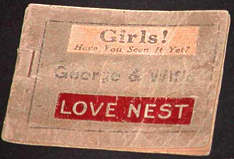 circa 1930 George & Wife 10 pager The "Girls" & "Love Nest" were applied after printing. Perhaps this copy was actually displayed somewhere where women might have seen it. |
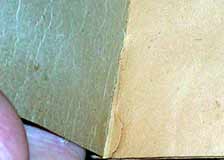 The first page (blank on both sides) was carefully torn out. Page 1 is the reverse of that next blank page. |
The Earliest Underground Comics
Sometimes
in the late 1920's the very first comic books appeared in America.... and
they were dirty ones!
Exactly when, where they
were printed, or which books came first ( if those survived at all) no one
can say. One thing is certain, though, from very early on distribution was
highly organized and they became available in a number of cities.
Very early series known
included the greats of the 20's, Barney Google, Toots & Casper, the
Gumps, Tillie the Toiler, Happy Hooligan, Abie the Agent, etc.
The earliest of these comics known, had nondescript or text covers, and were printed on white paper. Many were
actually as much as 12 pages in length. They were probably printed after hours in one
of the large plants in Newark or Brooklyn. Awkward printing &
folding often resulted in unevenly
paginated comics that often started
with blank pages and printing that jumped from side to side.
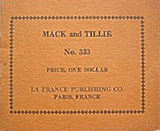 LaFrance 12 pager Mac & Tillie reprint early 1930's |
Some
of these early Tijuana Bibles are reprinted in their original 12 pages under the La France
imprint (Paris, France), the most popular of these books trickle down through
the 1930's, edited to the 8 page format as Tobasco Pub Co. (Havana, Cuba)
editions.
The Golden Age of Comics
Big Profits in Little Comics
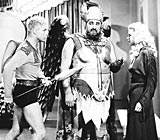 Buster Crabbe as Flash Gordon |
The
1930's was truly the Golden Age of Comics .... all comics, not just 8 pagers.
In 1929, Hal Foster's Tarzan
heralded the birth of the adventure comic strip and was followed by Buck Rogers,
Flash Gordon, Jungle Jim, Dick Tracy, Mandrake, the Phantom and hundreds
of others. Some of these characters made it to the movie screens as weekly
republic serials as well starring in their own tijuana bibles ... there's nothing like a cliffhanger to keep you on the
edge of your seat.
By the mid 1930's legitimate
comic books have switched from reprints of earlier syndicated newspaper
strips to brand new material. The newsstands are flooded with 64 page comics,
all in color for a dime .... while the 8 pager had an asking price of as
much as a buck each.
Eight pagers Marketing and cover styleBy
the early 30's we see cover motifs & even numbering, graphically
defining Eight Pagers as sets. Some examples include The Slash, Billboard,
Square w/ wrinkled sash , Spotlight , Marquee, Engagement Ring, Woven
Circle, Left Spot w/ deco bubbles, Cartoon Girl, etc. |
 Spotlight Design |
 Slash Design |
|
 Engagement Ring Design |
 Billboard Design |
 Woven Circle Design |
 Marquee Design |
The Most significant artists of the 1930's
Though
an unknown number of people contributed to
( and some detracted from ) the eight
pager over it's 75+ year history, it's creative foundation rests on the
work of a few. The most notable, called "Mr Prolific",
dominated the genre from around 1931
to 1938 and produced many of the greatest
classics.
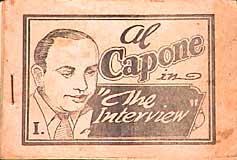 Al Capone was #1 with a bullet in Mr.Prolific's Underworld Series |
Prolific was as
capable as any comic pro, he had no problem drawing characters in their
familiar styles, and could nail the most well known likeness, as noted in
his Underworld Comics, and more obscure Radio Stars series.
Though his ultimate achievement
is "The Hip Flipper", a semi-fictional recounting of Mae
West's introduction to Hollywood debauchery in 32 beautifully drawn
pages, he is best remembered for his "Adventures of a Fuller Brush
Man", a series about an insatiable traveling salesman that spanned
10 eight pagers.
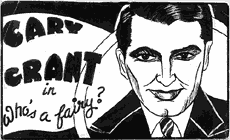 Rare 1938 Cary Grant original artwork |
Another
important but less recognized artist began sometimes in the mid 1930s, he
is known as "Blackjack", for the leathery, gnarled, menacing,
looking cocks he drew. Though he started with the usual cartoon parodies
he soon found his niche in celebrity Eight Pagers. He turned out the classic "Cary
Grant in who's a Fairy" as well as many other outrageous takeoffs
involving Hollywood's major and minor personalities. As these books were
dated by the stars popularity, many titles did not see the years of multiple
reprinting enjoyed by the cartoon classics, so his contribution is underrated.
In the late 1960's, in downtown
NYC, the original drawings to "Cary Grant" and several
other Eight Pagers are discovered in a print shop where they were possibly first
produced. These were recently acquired by TijuanaBible.org and will
be the centerpiece of a planned public exhibit exulting the dirty little
tombs.
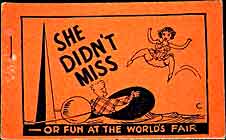 She Didn't Miss at the World's Fair |
 Wesley Morse's Copacabana Girl NYC 1940's |
Perhaps the most memorable of
all are the comics of Wesley Morse. While most 8 pager humor had a dark
side his books were lighthearted sex romps where everyone "came"
away happy. (sorry!)
Morse, a seasoned
pro of newspaper comics, and advertising, knew how to connect with his audience
through everyday scenarios we can all see ourselves in.
As an "A Train"
rider for many years, I particularly enjoy "It Started in the Subway
- and Ended in the Bronx". The fantasy of anonymous sex with a cute straphanger,
rings a bell with every urbanite who's ever fixated on rubbing against a
sexy stranger's ass!
His 1939 Worlds Fair
series comics are probably the most reprinted 8 pagers of all time. The notion
of sex at the Fair was innovative and fresh, even today these books get
the best reactions from new readers, especially Women.
It's important to note, Wesley Morse never used another cartoonist's characters in any of his 60 or so eight pagers.
Deluxe Tijuana Bibles with Ornate Borders
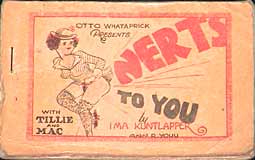 Nertz To You 10 pager |
By
the mid 30's the demand for new 8 pagers far outstripped their production
and books are being constantly reprinted (pirated), sometimes by numerous
publishers at the same time. The quality of these comics varied from excellent
to total crap.
There were some attempts at deluxe books like Mr. Prolific's
8 issue Ringside Series which includes John L. Sullivan and Max
Baer. These 10 pagers had 2 and even 3 color covers as well as exceptional
artwork.
There was also, "She Will Be Coming Around the Mountain",
"Art of Love by Popeye " , "Yes We Have No Bananas",
"Nertz to You", "Kansas City Kitty",
"The Lonely Widow" and others with 10 pages, .... some
of which are actually 8 page stories "padded" with 2 filler gag
pages. Altogether we know of 42 separate Tijuana Bibles titles sharing the Ornate Border
Imprint, both 8 and 10 pagers are included.
Click for part 2
Click for part 2
all
artwork and text copyright © 2004 2005 TijuanaBible.org
